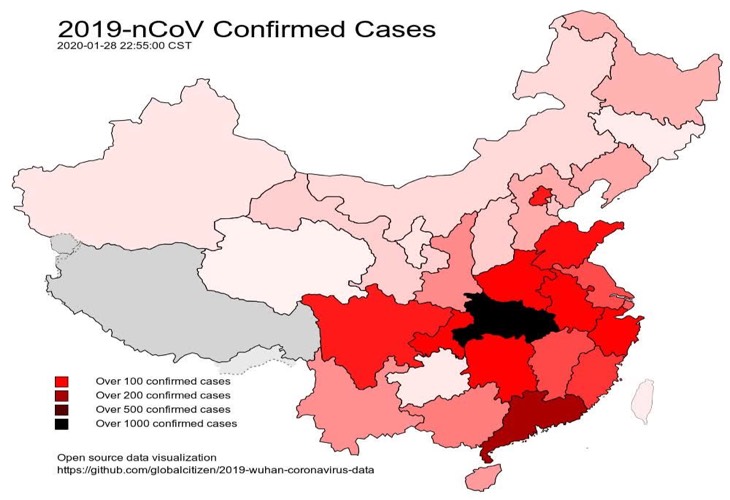Liu Zheng Zheng, of the Harvard Business Review China, based in Beijing, contributed to this report.
The 2019-nCoV situation deteriorated on multiple fronts in the first half of this week.
Key developments:
- The Chinese health ministry confirmed on Wednesday via state TV that 2019-nCoV is spreading in Beijing and other cities, with many cases observed among people who did not come from Wuhan. These are often family clusters.
- The Chinese health ministry also confirmed that 2019-nCoV is capable of spreading by skin contact.
- In China, confirmed case numbers, still doubling every two days, soared to almost eight thousand, exceeding the count Chinese of victims in the SARS epidemic 16 years ago, as the government began widening its lockdown to include regions outside Hubei.
- In the rest of the world, confirmed case numbers grew, with 105 confirmed cases in 19 countries and territories, with confirmation of human-human transmission of the virus in Vietnam, Taiwan, Japan, and a cluster of four related cases in Germany.
- Some countries and airlines outside China took a number of moves seemingly motivated by panic, such as Papua New Guinea banning travelers from Asia and shutting its land border with Indonesia, and a number of airlines stopping all flights to and from China.
- In response to these new developments, the WHO confirmed it will convene another emergency meeting Thursday to determine whether the widening epidemic merits PHEIC status.
However, despite all the bad news, the fundamental situation remains largely unaltered. The major questions experts have identified as most crucial to forecasting the long term future of the epidemic remain without answers: whether China’s quarantine will contain the growth in case numbers, and whether serial transmission of the virus will establish itself in other countries.
Several days remain before reassuring news either way could be expected, as the Wuhan quarantine and stronger international travel precautions only began to enter force seven days ago, and estimates of the virus’s incubation period range as long as 10 days.
Epidemic grows in China, lockdown widens, with quarantine effectiveness still unknown
In China, the epidemic continued growing on the established two-day doubling time, with confirmed cases swelling to 7711 in China and 7,783 worldwide: over 4500 in Hubei itself, and hundreds of others in each of a dozen Chinese provinces, among which the worst hit were Zhejiang, Guangdong, Henan, and Hunan, with over 250 cases each. For the first time, every province was affected by the coronavirus. Deaths from the coronavirus rose to 170.
The Chinese health ministry confirmed on Wednesday via state TV that 2019-nCoV is spreading in Beijing and other cities, with many cases observed among people who did not come from Wuhan. These are often family clusters. This was described as a “transition…from exported to disseminated cases.” This means that quarantine measures taken as of the time that those transmitting the virus arrived from Wuhan were not sufficient to arrest the spread of the virus.
In response to spread, the Chinese government began taking steps to expand the quarantine and lockdown even further. Medical experts on state television issued strong recommendations Wednesday that people in affected areas throughout China remain at home other than for critical needs, and avoid social gatherings.
Social media reports inside China indicate that local governments in some affected areas are treating the recommendation as quasi-mandatory, imposing conditions similar to those in Hubei.
Some major employers in China extended the new year holiday until February 9 or even longer, and many of those who have not suspended operations are allowing technical employees to work from home where possible.
In Wuhan itself, the lockdown continues under slightly eased conditions, and firsthand reports we’ve received from the city indicate that food and water are in adequate supply, while masks and gloves continue to be in critical shortage.
Around the world, tens of millions of people at once have been watching a 24 hour live stream of the construction of the new coronavirus-specific field hospitals in Wuhan. At press time, the site has been leveled, buildings have been framed over much of the site, a large entry plaza has been poured and is drying, and five construction cranes are busy erecting more buildings, including some stretching to a second story.
The doubling of the case numbers was largely expected. Current estimates of the incubation period of the virus are as long as 10 days, meaning that it may take up to 10 days for any particular security measure to be reflected in the growth of the real number of cases.
Moreover, changes in the ascertainment rate over time may either inflate or deflate the confirmed case trend relative to the real trend, e.g. by showing a reduction in growth as ascertainment tops out despite no real change in trend, or by allowing confirmed case numbers to continue rising rapidly as the number of real cases grows. There is an academic consensus that ascertainment rates have been rising, but no consensus on exactly how much or when it will top out.
The Hubei lockdown went into force over the course of several days from January 22 to 24, with those who fled Hubei settling down in their new environs in the following days, while the closure of public spaces throughout China went into force beginning on January 24. This means that a seven-day incubation period from January 22 would imply a slowing of cases from approximately today, while a ten-day period from the 24th would leave five days still on the clock.
Chinese state TV has announced that new case numbers are expected to top out on approximately February 5 in a best case scenario. The daily number of new confirmed SARS cases took about two weeks to see significant declines once it hit its top during the 2003 epidemic.
If the current rate of growth continued for another week, a relatively unlikely worst case scenario, the epidemic could see approximately eighty thousand confirmed cases by then.
2019-nCoV transmits outside China, can transmit by skin contact
The Chinese health ministry announced Tuesday that, confirming sporadic earlier reports, the 2019-nCoV strain can be spread by skin contact and is capable of infecting young children.
In addition, the Chinese health ministry appears to have formed a relatively short estimate of the virus’s incubation period, between 3 and 7 days.
The case count outside mainland China has risen to 105 in 19 countries and territories.
The coronavirus is confirmed to have transmitted from human to human in several countries outside China, including Vietnam, Japan, Germany, and Taiwan.
The Japanese case involved a Japanese man who is a tour driver for Chinese tourists. The Taiwanese case and the Vietnamese case both involve intra-family transmission. The German case, worst of all, involved coworkers of someone who recently returned from Wuhan and has expanded to a cluster of four related cases, probably four transmissions from one person.
In the United States, the case count still stands at five, with no confirmation of human-human transmission.
Much as in China, whether these cases portend a wider international outbreak with sustained transmission remains to be seen. Experts have told us the real sign of a sustained outbreak will be multiple generations of human transmission, and it will be a week or more before we can confirm whether this has begun happening. Similarly, it will be a couple days before (e.g.) cases arriving from Wuhan in the USA will likely be all accounted for.
But some institutions aren’t waiting. Countries and airlines outside China took a number of moves seemingly motivated by panic. Papua New Guinea banned travelers from Asia and shut down its land border with Indonesia, while small pacific island countries did similarly with China alone. A number of airlines including British Airways, Lufthansa, Swiss Air, and Austrian airlines stopped flights to and from China. Major airline stocks including China Southern, Lufthansa, and United Airlines are down about 20% since the start of the epidemic.
The WHO reconvenes
WHO Director-General Tedros Adhanom Ghebreyesus announced Wednesday he would convene the organization’s emergency committee to decide whether to declare the 2019-nCoV outbreak a Public Health Emergency of International Concern.
The WHO last week decided not to bestow this designation, but pledged to revisit within ten days. The worsening of the situation since then has made it much more likely that the PHEIC designation will be bestowed after Thursday’s meeting.

